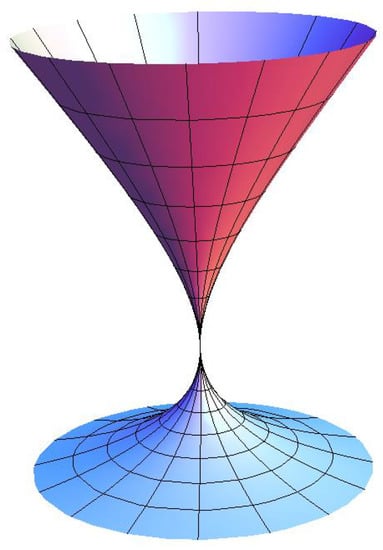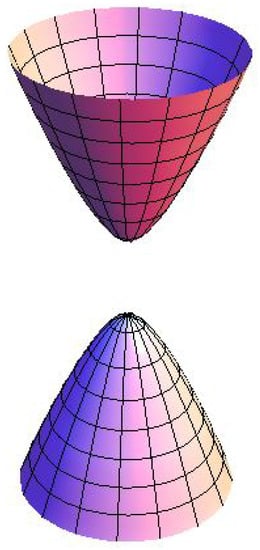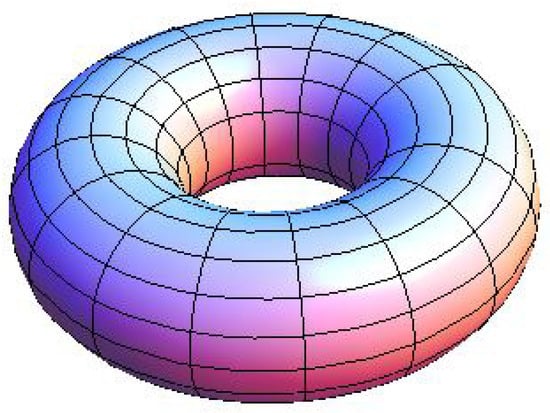Abstract
In the present work, the notion of generalized Cheng–Yau 1-type Gauss map is proposed, which is similar to the idea of generalized 1-type Gauss maps. Based on this concept, the surfaces of revolution and the canal surfaces in the Euclidean three-space are classified. First of all, we show that the Gauss map of any surfaces of revolution with a unit speed profile curve is of generalized Cheng–Yau 1-type. At the same time, an oriented canal surface has a generalized Cheng–Yau 1-type Gauss map if, and only if, it is an open part of a surface of revolution or a torus.
1. Introduction
The finite-type immersion and finite-type Gauss map proposed by B. Y. Chen are of great use in classifying and characterizing submanifolds whether they are in a Euclidean space or in a pseudo-Euclidean space [,]. The related research achievements are so numerous due to the continuous generalizations of such ideas on different submanifolds and in different spacetimes [,]. Taking the finite-type Gauss map as an example, the simplest type of finite-type Gauss map is the 1-type Gauss map. An oriented submanifold is of 1-type Gauss map when its Gauss map fulfills for some non-zero constant and a constant vector C; the Laplace operator is given by
where are the components of the inverse matrix of . Spheres, circular cylinders and planes in Euclidean three-space are representatives which have 1-type Gauss maps []. Being a development of the 1-type Gauss map, the notion of a pointwise 1-type Gauss map of submanifolds is put forward by one of the present authors and D. W. Yoon []. An oriented submanifold with a pointwise 1-type Gauss map fulfills for a constant vector C and a non-zero smooth function f. Catenoids, helicoids and right cones in Euclidean three-space are typical surfaces with pointwise 1-type Gauss maps [].
By extending the concept of submanifiolds with pointwise 1-type Gauss maps, submanifolds with generalized 1-type Gauss maps can be defined. Namely
Definition 1.
Ref. [] A submanifold in is of generalized 1-type Gauss map if its Gauss map satisfies
non-zero smooth functions and constant vector .
It is not difficult to find that the generalized 1-type Gauss map of submanifolds is a kind of extension of the 1-type Gauss map and pointwise 1-type Gauss map. The authors of [] completely classified the developable surfaces, in Euclidean three-space, of the generalized 1-type Gauss map. The canal surfaces and the surfaces of revolution of generalized 1-type Gauss maps have been discussed recently [].
In 1977, S.Y. Cheng and S.-T. Yau introduced a second-order differential and self-adjoint operator , named the Cheng–Yau operator, which is defined on a closed orientable Riemannian manifold with a local orthonormal frame field and a dual coframe field , where has a symmetric tensor, as follows:
which satisfies the Cheng–Yau condition
where is the covariant derivative of the tensor with respect to the metric g in the direction . Then, the Cheng–Yau operator of any -function f is defined by []
In recent years, the concepts of finite-type and pointwise 1-type Gauss maps for the submanifolds in Euclidean space have been extended and have taken the place of the Laplace operator with the Cheng–Yau operator □. A submanifold is an -pointwise 1-type Gauss map when its Gauss map can be expressed as for a constant vector C and a non-zero smooth function f. Moreover, when f is a non-zero constant, is said to have a -1-type Gauss map. The rotational and helicoidal surfaces of -pointwise 1-type Gauss map have been discussed in []. Two authors of this paper classified the canal surfaces of -pointwise 1-type Gauss map [].
Similar to the idea of generalized 1-type Gauss map, we could define and discuss the submanifolds of generalized Cheng–Yau 1-type Gauss maps. In Section 2, the gradient of a smooth function f is defined on a submanifold and some fundamental elements of canal surfaces are recalled. In Section 3, the surfaces of revolution and the canal surfaces of generalized Cheng–Yau 1-type Gauss maps are surveyed, respectively. Last but not least, some typical examples are presented via the Mathemtica programme.
The surfaces discussed here are regular, smooth and topologically connected.
2. Preliminaries
Let be an oriented surface in the Euclidean three-space . Then, the gradient of a smooth function f, which is defined in , can be expressed by
where is a local coordinate system of , s.t. , and , , and are the partial derivatives of f, respectively [].
According to the definition of the Cheng–Yau operator of a function f [], the following conclusion is straightforward and useful.
Lemma 1.
Ref. [] Let be an oriented surface whose Gaussian curvature and mean curvature are denoted by K and H in . Then, the Cheng–Yau operator acting on its Gauss map can be expressed by
Remark 1.
From Lemma 1, an oriented surface has an -harmonic Gauss map if it is flat; is of the first kind of -pointwise 1-type Gauss map if its Gaussian curvature is a non-zero constant.
Motivated by the submanifolds of the generalized 1-type Gauss map in Euclidean space, the following definition is natural.
Definition 2.
An oriented submanifold is of a generalized Cheng–Yau 1-type Gauss map in the Euclidean space if its Gauss map satisfies
for non-zero smooth functions and constant vector .
Remark 2.
Obviously, when f and g are non-zero constants, the Gauss map is just an -1-type Gauss map; when the function f is equal to g, it is a Gauss map of the -pointwise 1-type. Furthermore, the -pointwise 1-type Gauss map is called the first kind for and, otherwise, the second kind. When f and g vanish, is called the -harmonic.
In , there exist important and useful surfaces called canal surfaces, which are swept out by moving spheres along space curves. Based on previous works about such surfaces [,,], we focus on the canal surfaces of generalized Cheng–Yau 1-type Gauss maps in this work.
Assuming be a space curve in with an arc-length parameter s and Frenet frame , according to the generating procedure of canal surfaces, a canal surface can be expressed as
where , () and . The curve is said to be the center curve, is said to be the radial function of . In sequence, are called the unit tangent, and the principal, normal and binormal vector fields of , respectively.
Remark 3.
In particular, when is a straight line, is just a surface of revolution; is a tube (or pipe surface) when is a constant.
To serve the following discussions, we prepare some basic elements of canal surfaces. Initially, by the aid of the Frenet formula of , from (4), we have
where
Meanwhile, the Gauss map of is given by
from which we have
Remark 4.
From due to the regularity of , .
Simultaneously, we observe the following conclusion.
Proposition 1.
Ref. [] The Gaussian curvature K and the mean curvature H of a canal surface in are related by
Next, we focus on the surfaces of revolution and the canal surfaces that have generalized Cheng–Yau 1-type Gauss maps, respectively.
3. Surfaces of Revolution with Generalized Cheng–Yau 1-Type Gauss Map
Let be a surface of revolution in parameterized by
for some smooth functions, and . Assuming that the profile curve is of unit speed, i.e., , a direct computation shows that
At the same time, the Gauss map of is
from which we have
By some calculations, the first fundamental form and the second fundamental form are
and
If has a generalized Cheng–Yau 1-type Gauss map, i.e., , where is a constant vector, by substituting (15) and (20) into (3), we obtain
The second and third equations of (21) imply that , obviously. Moreover,
where is a constant.
Conversely, when we make use of the given functions and , a surface of revolution with a unit speed profile curve satisfies for such functions given by (22) and constant vector . Thus, we have the following result.
Theorem 1.
Any surface of revolution with a unit speed profile curve in has a generalized Cheng–Yau 1-type Gauss map. Explicitly, the Gauss map of fulfills
for some non-zero smooth functions given by (22) and the constant vector , where is a non-zero constant.
4. Canal Surfaces with Generalized Cheng–Yau 1-Type Gauss Map
Assuming that an oriented canal surface is of the generalized Cheng–Yau 1-type Gauss map kind, then, by Lemma 1, we have
Note that, from (11) and (12), the partial derivatives of the Gaussian curvature K are
By substituting (7), (24) and (25) into (23), we get
According to the above equation system, we have the following two cases.
: . From the first equation of (27), we have
by substituting (28) into the last two equations of (27), we obtain
From (29), we have
Since constitutes a linearly independent function system, when analyzing the coefficients of and in (30) by the aid of (5), (9) and (26), we have
Based on Equation (31), we think of a non-empty subset . Because , , we know on . By substituting them into (30), we have
Furthermore, by contrasting the coefficient of the highest degree of in (32), we obtain that , then . In this situation, is of the first kind of - pointwise 1-type Gauss map, i.e., . From the Theorem 3.2 of [], is an open part of a surface of revolution, i.e., . Thus, is empty; when . In this case, is a surface of revolution.
By simplifying (30) with the help of , we have
Note that or else and is degenerate. If , then has constant Gaussian curvature due to when . From Reamrk 1, is of the first kind of - pointwise 1-type Gauss map. Therefore, and (33) follow that . Furthermore, from (27) we have
where is a non-zero constant. As , are all functions of s, (34) yields . Explicitly, we have
Therefore, is of the generalized Cheng–Yau 1-type Gauss map for functions given by (35) and the vector , where .
Because is a surface of revolution, we can put in (4) with Frenet frame . Therefore, can be expressed by
: , i.e., is a tube surface.
First of all, suppose that Then, we get, from the first equation of (27),
Considering the coefficient of the power of in (38) with the help of (9) and (26), we get ; hence, . However, when and , is part of a circular cylinder. By Remark 1, it has an harmonic Gauss map. It is a contradiction; therefore, .
Looking back at the first equation of (27) together with and , we have , i.e.,
therefore, and , then the center curve is a circle and is a torus.
Furthermore, from the last two equations of (27), we have
where .
Since V, P, K and H are all functions of when and is a constant, (39) yields that the functions only depend on . Explicitly, we have
Therefore, is of the generalized Cheng–Yau 1-type Gauss map for functions given by (40) and the vector , where .
Conversely, suppose is an open part of a surface of revolution or a torus; we can easily find that is fulfilled for some non-zero smooth functions given by (35) and (40) with the constant vectors and , respectively.
According to the above discussion works, we have the following results.
Theorem 2.
An oriented canal surface is of the generalized Cheng–Yau 1-type Gauss map if it is a torus or an open part of a surface of revolution with the following form:
As immediate consequences of the above theorem, we have
Corollary 1.
Let an oriented canal surface with a generalized Cheng–Yau 1-type Gauss map be an open part of a surface of revolution. Then, the Gauss map of satisfies
for some non-zero smooth functions given by
and the vector , (.
In particular, when the canal surface with a generalized Cheng–Yau 1-type Gauss map is an open part of a surface of revolution, which has a profile curve of unit speed, we have the following result.
Corollary 2.
Let an oriented canal surface with a generalized Cheng–Yau 1-type Gauss map be an open part of a surface of revolution that has a profile curve of unit speed. Then, the Gauss map of fulfills
for some non-zero smooth functions given by (42) and the constant vector , where is a non-zero constant. Moreover, the radius function of is given by (44) explicitly.
Proof.
By comparing the parametrization of , as stated in Theorem 2, with the general form of the surface of revolutionm as stated in (13), we can let , s.t. , i.e.,
Because of the assumption for canal surfaces, , from the above equation, we have
By combining the the expression forms of in (35) and (22), we have
where, for ; for .
Furthermore, by solving differential Equation (41), we get
Then we obtain a real solution of as follows:
where □
Corollary 3.
Let an oriented canal surface with a generalized Cheng–Yau 1-type Gauss map Gauss map be a torus. Then, the Gauss map of satisfies
for some non-zero smooth functions , given by
and the vector in which and
Remark 5.
The canal surfaces that have -pointwise 1-type Gauss maps and the ones that have -1-type Gauss maps have been discussed in []; we do not repeat them here.
5. Examples
In this section, we present some typical examples of Cheng–Yau generalized 1-type Gauss maps.
Example 1.

Let be a surface of revolution, as follows (see Figure 1):

Figure 1.
The surface of revolution in Example 1.
After calculations, its Gauss map is whose Cheng–Yau operator can be expressed as
Example 2.

Let be a surface of revolution that has a profile curve of unit speed and is parameterized by (see Figure 2)
where is given by
in which .

Figure 2.
The surface of revolution in Example 2.
Example 3.

Let be a torus parameterized by (see Figure 3)

Figure 3.
The torus in Example 3.
Through calculations, we find that its Gauss map is whose Cheng–Yau operator can be expressed as
Based on the definitions of canal surfaces in Minkowski three-space [,], the canal surfaces in will be classified in terms of their Gauss maps via the Laplacian operator and the Cheng–Yau operator in the near future.
Author Contributions
J.Q., X.F. and X.T. proposed the problem and calculated the details. Y.H.K. checked and polished the draft. All authors have read and agreed to the published version of the manuscript.
Funding
The first author was supported by National Natural Science Foundation of China (No. 11801065) and the Fundamental Research Funds for the Central Universities (N2005012). The fourth author was supported by the Basic Science Research Program through the National Research Foundation of Korea (NRF), which is funded by the Ministry of Education (NRF-2020R1I1A3051852).
Acknowledgments
We thank the referee for their careful review and the valuable comments that helped us to improve the paper.
Conflicts of Interest
The authors declare no conflict of interest.
References
- Chen, B.Y. A report on submanifolds of finite type. Soochow J. Math. 1996, 22, 117–337. [Google Scholar]
- Chen, B.Y.; Piccinni, P. Submanifolds with finite type Gauss map. Bull. Austral. Math. Soc. 1987, 35, 161–186. [Google Scholar] [CrossRef]
- Baikoussis, C.; Verstralen, L. The Chen-type of the spiral surfaces. Results Math. 1995, 28, 214–223. [Google Scholar] [CrossRef]
- Dursun, U. Hypersurfaces with pointwise 1-type Gauss map. Taiwanese J. Math. 2007, 11, 1407–1416. [Google Scholar] [CrossRef]
- Yoon, D.W.; Kim, D.S.; Kim, Y.H.; Lee, J.W. Hypersurfaces with generalized 1-type Guass maps. Mathematics 2018, 6, 130. [Google Scholar] [CrossRef]
- Kim, Y.H.; Yoon, D.W. Ruled surfaces with pointwise 1-type Gauss map. J. Geom. Phys. 2000, 34, 191–205. [Google Scholar] [CrossRef]
- Qian, J.H.; Su, M.F.; Kim, Y.H. Canal surfaces with generalized 1-type Gauss Map. Rev. Union Math. Argent. Preprint.
- Cheng, S.Y.; Yau, S.-T. Hypersurfaces with constant scalar curvature. Math. Ann. 1977, 225, 195–204. [Google Scholar] [CrossRef]
- Kim, Y.H.; Turgay, N.C. Classification of helicoidal surfaces with -pointwise 1-type Gauss map. Bull. Korean Math. Soc. 2013, 50, 1345–1356. [Google Scholar] [CrossRef]
- Qian, J.H.; Kim, Y.H. Classifications of canal surfaces with -pointwise 1-type Gauss Map. Milan J. Math. 2015, 83, 145–155. [Google Scholar] [CrossRef]
- Kim, Y.H.; Turgay, N.C. Surfaces in with -pointwise 1-type Gauss map. Bull. Korean Math. Soc. 2013, 50, 935–949. [Google Scholar] [CrossRef]
- Kim, Y.H.; Liu, H.L.; Qian, J.H. Some characterizations of canal surfaces. Bull. Korean Math. Soc. 2016, 53, 461–477. [Google Scholar] [CrossRef]
- Qian, J.H.; Kim, Y.H. Some classification of canal surfaces with the Gauss Map. Bull. Malays. Math. Sci. Soc. 2019, 42, 3261–3272. [Google Scholar] [CrossRef]
- Fu, X.S.; Jung, S.D.; Qian, J.H.; Su, M.F. Geometric charecterizations of canal surfaces in Minkowski 3-space . Bull. Korean Math. Soc. 2019, 56, 867–883. [Google Scholar]
- Qian, J.H.; Su, M.F.; Fu, X.S.; Jung, S.D. Geometric characterizations of canal surfaces in Minkowski 3-space . Mathematics 2019, 7, 703. [Google Scholar] [CrossRef]
© 2020 by the authors. Licensee MDPI, Basel, Switzerland. This article is an open access article distributed under the terms and conditions of the Creative Commons Attribution (CC BY) license (http://creativecommons.org/licenses/by/4.0/).